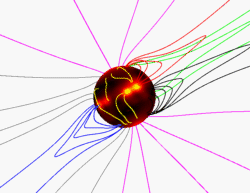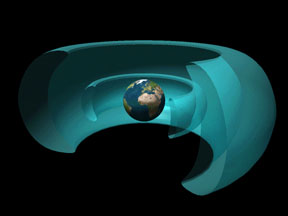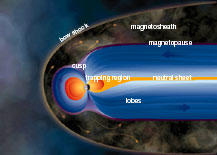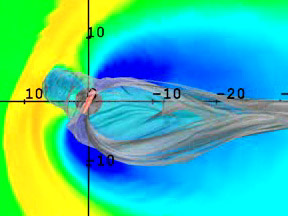Movie courtesy of the Center for Space Environment Modeling (CSEM), University of Michigan.
Model of a CME - Sun to Earth
This movie shows the results of a computer model of a coronal mass ejection (CME) as it travels from the Sun to Earth. Right-click (Windows) or Option-click (Mac) here to download a copy of this video in QuickTime format.
At the start of the movie, the Sun is represented by the small black circle near the left edge of the screen. Different colors (red through yellow, green, and blue) represent the density of subatomic particles of solar wind radiation. Red represents high density, while blue is low density. Values range from 100,000 particles per cubic centimeter (red) down to 1,000 particles per cubic cm. White lines represent magnetic field lines. The distance scales along the x- and y-axes are in units of solar radii (RS). At the start, the x-axis extends about 30 times the radius of the Sun to the right. The scale changes as the movie runs.
A coronal mass ejection (CME) blasts away from the Sun towards the right. It appears as an oval "bubble" of magnetic field lines. The CME moves away from the Sun and our view zooms out. A shock wave forms along the leading edge of the CME where the density of solar wind particles increases (shown in red). The CME reaches a distance of about 200 solar radii from the Sun. At this point, our view zooms in to show Earth (another black circle) surrounded by our planet's magnetic field (white lines). A multicolored wave representing the CME sweeps over Earth's magnetosphere, shifting and disrupting Earth's magnetic field.
The movie displays a grid of black lines around Earth to illustrate how the computer model works. The computer model repeatedly calculates the conditions (particle density, magnetic field strength, and so on) inside each square box (modellers call these boxes "cells") represented in the model. Note how the grid cells have different sizes. The cells are smallest near Earth, where it is especially important to scientists to see model results in detail. Further away from Earth, the grid cells are larger. Larger (and thus fewer) cells require less computer processing time to run the model. This is important, for complex models like this one can take days to run... even on very fast supercomputers.













